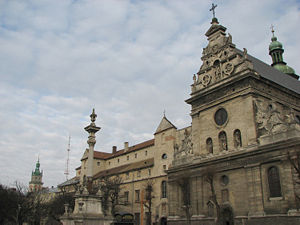
Bernardine Church, Lviv
Encyclopedia

Lviv
Lviv is a city in western Ukraine. The city is regarded as one of the main cultural centres of today's Ukraine and historically has also been a major Polish and Jewish cultural center, as Poles and Jews were the two main ethnicities of the city until the outbreak of World War II and the following...
is located in the city's Old Town
Old Town (Lviv)
Lviv's Old Town is the historic centre of the western Ukrainian city of Lviv, in the Lviv Oblast , recognized as the State Historic-Architectural Sanctuary in 1975.-UNESCO:...
, south of the market square. The monastery along with the Roman Catholic church of St. Andrew, today the Greek Catholic church of St. Andrew, now belong the Order of St. Basil the Great.
The Franciscan
Franciscan
Most Franciscans are members of Roman Catholic religious orders founded by Saint Francis of Assisi. Besides Roman Catholic communities, there are also Old Catholic, Anglican, Lutheran, ecumenical and Non-denominational Franciscan communities....
Observantists, known in the region as Bernardines after their monastery in Kraków
Kraków
Kraków also Krakow, or Cracow , is the second largest and one of the oldest cities in Poland. Situated on the Vistula River in the Lesser Poland region, the city dates back to the 7th century. Kraków has traditionally been one of the leading centres of Polish academic, cultural, and artistic life...
in order to distinguish them from Franciscan Conventuals, were invited to Lviv by Andrzej Odrowąż
Andrzej Odrowaz
Andrzej of Sprowa Odrowąż was a 15th century Polish noble and statesman, starost of Ruthenia and Voivode of Podolia. He is best known as the founder of the Bernardine Church in Lwów....
in 1460. In 1509 the monastery was plundered by the Moldovan hospodar Bogdan III cel Orb
Bogdan III cel Orb
Bogdan III the One-Eyed or Bogdan III the Blind Voivode of Moldavia from July 2, 1504 to 1517.-Family:He was born in Huşi as the son of Voivode Ştefan cel Mare and his wife Maria Voichiţa...
. In the 17th century the present day church and monastery were constructed in the same place in the style of Italian and Dutch mannerism
Mannerism
Mannerism is a period of European art that emerged from the later years of the Italian High Renaissance around 1520. It lasted until about 1580 in Italy, when a more Baroque style began to replace it, but Northern Mannerism continued into the early 17th century throughout much of Europe...
and consecrated in 1630. As the complex was located outside Lviv's city walls it was equipped with its own fortifications from the east and south, mostly taken apart at the beginning of the 19th century. In 1733 square belfry was added to the complex and in 1736 a monument to Saint John of Dukla, who died in the monastery in 1484, was built in front of the church.
The interior was refurbished in the Baroque
Baroque
The Baroque is a period and the style that used exaggerated motion and clear, easily interpreted detail to produce drama, tension, exuberance, and grandeur in sculpture, painting, literature, dance, and music...
style in the years 1738–1740. The church managed to avoid being closed by the Austrian emperor Joseph II, although part of the monastery was taken over for the city archive. After the Second World War the church was closed by Soviets and fell into disuse until the collapse of the Soviet Union when it was returned to the faithful, since 1991 the complex is under the care of Ukrainian Greek Catholic Basilian Order and has undergone thorough renovation. Just around the corner stands the Hlyniany Gate
Hlyniany Gate
Hlyniany Gate is the focal point of the few remaining fortifications in Lviv, Ukraine. It was built in 1618 to Fryderyk Getkant's designs in order to defend the approach from Hlyniany. The outer moat and the wooden galleries on the inside are the upshot of a 1970s reconstruction...
.

